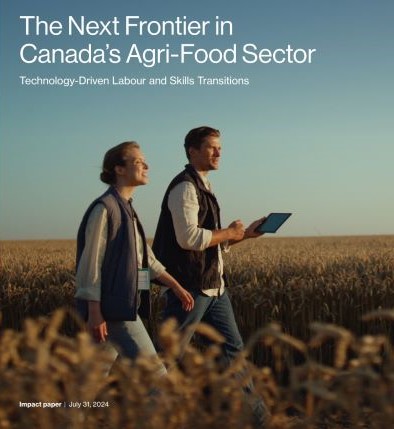Significant number of agriculture and food and beverage manufacturing jobs face automation within next decade: Conference Board of Canada
 One-third of Canada’s agricultural jobs and one-fifth of food and beverage manufacturing jobs are at risk of automation in the next decade, says a study by the Conference Board of Canada (CBoC).
One-third of Canada’s agricultural jobs and one-fifth of food and beverage manufacturing jobs are at risk of automation in the next decade, says a study by the Conference Board of Canada (CBoC).
Canada’s agri-food sector employed 563,000 people in 2023, or about 2.8 percent of total employment, according to the report, The Next Frontier in Canada’s Agri-Food Sector: Technology-Driven Labour and Skills Transitions, done in collaboration with the Future Skills Centre.
“Understanding technology trends in agri-food is crucial for workers, sector representatives and educators in preparing for the future of work in the sector,” the study says.
In the agriculture industry, the study found that 103,665 jobs are at risk of automation, while 56,130 jobs are at risk in food and beverage manufacturing. In both industries, these jobs have limited transition options to new types of work without upskilling or reskilling.
For the agriculture industry’s workforce, precision agriculture, advanced machinery and sensor technology tools have the highest potential to automate repetitive tasks, improve efficiency, enable data-driven decision-making and optimize resource management.
In the food and beverage manufacturing industry, robotics, automation, artificial intelligence and advanced analytics hold the greatest potential to increase efficiency and consistency in food processing and packaging, enable data-driven decision-making, and improve overall operational performance.
Occupations increasing in demand in agriculture include greenhouse workers, horticulture technicians and biological technologists, while food and beverage manufacturing requires process control and machine operators, industrial mechanics and manufacturing managers, the study says.
“Although information technology occupations account for a very small share of sectoral employment, those projected to grow the fastest over the next decade include data scientists and software engineers.”
The skills most in demand for the future agriculture workforce are product design, digital production and digital literacy, while the food and beverage manufacturing industry will be looking for skills such as digital literacy, problem-solving, evaluation, systems analysis and monitoring.
For the study, co-authors Zafer Sonmez, Daniel Carpenter and Nicholas Palaschuk leveraged Statistics Canada and The CBoC’s labour market information, complemented with information from interviews with 10 key informants, to identify occupations that are emerging as pivotal to the sector’s future growth.
Canada’s agri-food sector generated $72.1 billion in value-added or around 3.3 percent of Canada’s GDP, with agriculture contributing to 1.7 percent of GDP and the food and beverage manufacturing industry contributing to 1.6 per cent, according to the study.
The sector benefits from abundant land and water resources and a strong global reputation as a trusted supplier of safe, high-quality food, the study says. “These factors have the potential to make Canada a leader in sustainable food production and processing.”
However, taking advantage of these opportunities and leveraging the country’s strengths depends on the sector’s ability to adapt to technological change and access a qualified labour force, the study notes. “Only then can the sector remain competitive, sustainable, resilient, and prosperous into the future.”
In a study published by the Information and Communication Technology Council of Canada, Canada ranked seventh globally in the total dollar value of new agri-food technology investments (US$508 million) and sixth in the number of new deals.
According to a 2021 survey by Agriculture and Agri-Food Canada, 64 percent of farms with annual revenues over $1 million reported using precision agriculture technologies, compared with only 24 percent of farms with revenues under $100,000.
In food and beverage manufacturing, the adoption of automation and robotics has been more prevalent in larger, well-established companies, while smaller businesses have often faced barriers to adoption due to high costs and a lack of in-house expertise.
Automation can address labour shortages but impacts on some jobs can be large
Canada’s agriculture industry regularly faces labour shortages, the study notes. For example, even with tens of thousands of seasonal foreign workers supporting the industry during periods of peak demand, the ratio of job vacancies to employment in the industry has, on average, been 11 percent above the Canadian average over the past four years.
Also, with an older-than-average workforce, the industry will face high retirement rates. On average, more than 10,600 workers, including owner-operators, are expected to retire each year between 2023 and 2030, for a total of over 85,300 retirements or almost 30 percent of the industry’s current Canadian workforce.
“As businesses struggle to find and retain skilled workers, they are increasingly turning to automation and advanced technologies to fill this gap,” the study says.
However, despite the potential benefits, the study points out that Canada’s agri-food sector is displaying a lethargic record of technology adoption in the face of several key barriers. Perceived insufficient returns on investment, a lack of government support and funding, and a lack of in-house expertise to guide the process are slowing the rate of adoption.
The agriculture industry currently employs workers from 308 different occupations, while the food and beverage manufacturing industry employs workers from 258 different occupations.
But employment in these industries is highly concentrated among a limited number of occupations. In the case of agriculture, the top five occupations account for 70 percent of employment, while in food and beverage manufacturing the top five occupations account for 45 percent of employment.
“With agri-food employment concentrated in a handful of occupations, the automation impacts can be large,” the study says. “Automation and labour shortages will both contribute to a decline in domestic employment in agriculture over the next decade.”
Domestic employment in agriculture is projected to decrease by 0.8 percent from 2023 to 2033, but there are a wide range of differences in the growth rates of different occupations.
The top five fastest-growing occupations in agriculture over the next decade, in terms of absolute employment gains, will experience growth ranging from 9.7 percent to 41.4 percent. These occupations reflect the increasing emphasis on specialized skills in plant care, transportation logistics and animal welfare, aligning with advancements in agricultural technology.
Conversely, the top five declining occupations in agriculture are projected to see decreases ranging from 4.7 percent to 9.5 percent. These declines underscore automation’s impact on traditional managerial roles and manual labour tasks as well as the streamlining of administrative functions through technological integration.
In food and beverage manufacturing, overall employment in the industry is predicted to rise by 2.3 per cent between 2023 and 2033. However, the growth rates of various occupations will vary considerably, with some experiencing rapid expansion and others facing decline or even contraction.
Targeted training and upskilling is required in the sector
One of the major challenges for the agri-food sector is to prepare for technological change and adoption, the study says.
Employers will need to recruit for new types of roles and skills, while creating pathways for vulnerable workers to upskill and transition to these new roles.
Enhancing training and/or upskilling is especially important in the context of agri-food in Canada, given that this sector is more likely to operate in rural regions where the talent pool is smaller and residents often lack equal access to training opportunities.
“Given the limited supply of workers, the expected technological shifts will require the sector to make the best use of the people that are available,” the study says. This will mean retraining existing workers so they can shift from roles where demand is shrinking to those where it is growing.
In the agriculture industry, the study found that managing and delivering “client services” will be the most required skill in the future, “underscoring the heightened emphasis on customer-centric approaches and relationship management in evolving roles.”
Also important in the agriculture industry will be skills in vehicle and machinery operations, chemistry, water resources, and manufacturing, processing and production, “highlighting the growing importance of technical expertise and domain-specific knowledge in modernizing agricultural practices.”
In the agriculture industry, workers in declining occupations appear to already possess many of the attributes required for growing occupations,” making [workforce] transitions more feasible,” requiring only minor upskilling or reskilling.
However, occupational changes in the food and beverage industry will require much more involved upskilling than those in agriculture.
Workforce transitions in food and beverage manufacturing are much more likely to require significant investments in targeted training programs, the study notes.
The top five abilities where skills retraining in food and beverage manufacturing need to be focused are: fluency of ideas; mathematical reasoning; problem identification; information ordering; and pattern identification.
The first two abilities underscore the role of creativity and analytical thinking in growing occupations. The next three abilities highlight the importance of efficient troubleshooting, streamlined production processes, and effective quality control where workers are able to recognize, prioritize and discern patterns in complex production settings.
The top five skills required in the food and beverage industry’s future workforce will be: digital literacy; problem-solving; evaluation; systems analysis; and monitoring, the study says.
Digital literacy highlights the growing importance of digital tools and platforms in modernizing production processes and leveraging data-driven insights, the study notes. “The other skills underscore the heightened emphasis on analytical thinking and systematic approaches to problem-solving in response to complex operational challenges.”
Recommendations to facilitate a smooth workforce transition
By embracing automation and technological advancement, Canada’s agri-food sector stands to increase productivity and competitiveness, potentially exceeding those seen in many other industries, while addressing some of the labour challenges it faces, the study says.
To facilitate a smooth transition and help strengthen the industries’ competitiveness, the report recommends:
- Invest in both education and professional development programs: Policymakers and sector stakeholders should prioritize training initiatives that enable workers to effectively adopt and integrate advanced technologies in the agri-food sector. These programs should focus on developing workers’ proficiencies in digital tools, product design and complex problem-solving, as well as emphasizing soft skills such as adaptability. By providing workers with opportunities to acquire these sought-after skills, policymakers and sector stakeholders could help bridge the skills gaps that currently hinder the adoption of advanced technologies in the agri-food sector as well as help transition at-risk workers.
- Promote the role of farming and food production and debunk stereotypes to attract more tech-focused individuals into the sector: Given the challenge of rural recruitment, sector stakeholders and educational institutions should showcase the innovative and technologically advanced aspects of modern agriculture and food production. Challenging outdated perceptions and attracting a diverse, tech-savvy workforce is needed. For example, emphasizing how the use of advanced technologies such as drones, robotics, AI, sensors and data analytics are revolutionizing traditional farming and manufacturing practices can attract tech-savvy workers into the sector. Moreover, illustrating how agri-food professionals contribute to finding solutions for global food security, environmental sustainability and resource management could help recruit new and younger talent to the sector.
- Support small-to-medium-sized farmers in providing in-house or manufacturer training to their staff: As equipment becomes more specialized, training will become increasingly important. Government and industry organizations could provide support and resources to enable small to medium-sized agri-food stakeholders, such as primary producers, processors and distributors, to offer this training to their employees, either in-house or through a manufacturer. Moreover, governments could offer financial support in the form of grants, subsidies or low-interest loans to these stakeholders for investing in training programs and purchasing equipment for employee training. Additionally, industry organizations could facilitate partnerships between agri-food stakeholders and equipment manufacturers to develop tailored training programs that address the specific needs and challenges of each industry.
- Facilitate the creation of knowledge-transfer programs, connecting aging farmers with new entrants in their region: Policymakers and industry associations could develop and promote initiatives that foster mentorship and knowledge-sharing between experienced farmers and new entrants. Programs like this could advance the industry by ensuring that workers are provided with new knowledge through the preservation and transfer of valuable skills and expertise around planting and harvesting schedules, crop rotation, soil management, irrigation, pest control and breeding.
Says the study: “Strategies for upskilling and reskilling workers are a key part of ensuring that Canada’s agriculture and food and beverage manufacturing industries not only adapt to technological advancements but also lead the way in innovation and sustainability.”
R$
Events For Leaders in
Science, Tech, Innovation, and Policy
Discuss and learn from those in the know at our virtual and in-person events.
See Upcoming Events
You have 0 free articles remaining.
Don't miss out - start your free trial today.
Start your FREE trial Already a member? Log in
By using this website, you agree to our use of cookies. We use cookies to provide you with a great experience and to help our website run effectively in accordance with our Privacy Policy and Terms of Service.





